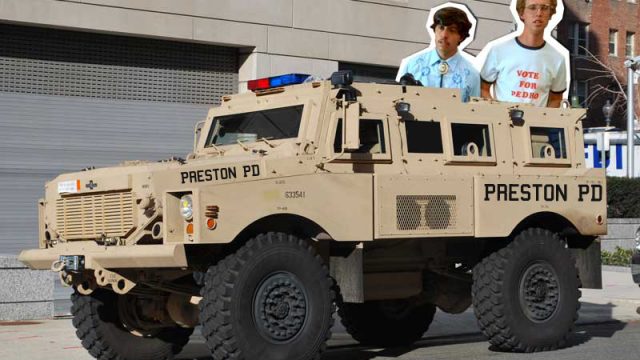Napoleon Dynamite upgrades from nunchuks to military tank as police state creeps forward

SWEET: Napoleon and Pedro roll in a military grade vehicle donated to the Preston Police Department.
By Dustin Hurst | Watchdog.org
Nearly a decade ago, a bespectacled loner with sweet bo-staff skills offered a dire indictment of his small Idaho high school.
“You know … there’s like a butt-load of gangs at this school,” Napoleon Dynamite told Pedro Sanchez, his Mexican immigrant pal with political ambitions.
To save himself in the gang-ridden school in Preston, Idaho, Napoleon relied on his bo-staff, nunchuks and, if things got real heavy, his wolverine-killing 12-gauge shotgun — at least until local police decided to pitch in.
Recently, Preston police stepped up in a major way: They acquired a military-grade vehicle previously used on the streets of Iraq and Afghanistan, a behemoth truck originally designed for protecting American soldiers from roadside bombs.
If the massive truck — known as an MRAP — seems an odd fit for Preston, a tiny town of just more than 5,000 in southeastern Idaho, it’s because it’s just that. The city’s crime checks in far below the U.S. average, and there’s hasn’t been a murder there since 2006. The city’s not exactly a crime-ridden hell hole where police might need an ambush-resistant and bomb-proof troop carrier.
An eight-week course of Rex Kwon Do just wasn’t enough for residents of Preston, I guess.
The city’s ownership of such heavy equipment reveals a few of inconvenient and uncomfortable truths for people worried about the creep of the modern militarized police state: It’s here, it doesn’t care the size of your town and officials really don’t care about your concerns.
That’s evident by the places these vehicles are popping up across the map as the American military winds down its efforts overseas. Another tiny town, Storm Lake, Iowa, recently received one. Storm Lake, like Preston, is far from a haven for crooks, mobsters or gangsters. The town hasn’t logged a murder since 2001.
Besides procurement of ostentatious military vehicles, the creep of the paramilitary police state reveals itself in other ways.
Take 30 seconds to watch a police recruiting video for the Hobbs Police Department in Hobbs, N.M., a town of just more than 43,000. Instead of protect and serve, the clip shows police busting into a home in full SWAT gear. The video also features the town’s SWAT truck, a heavily armored vehicle in its own right.
Radley Balko, author of “Rise of the Warrior Cop,” wrote this about the message the Hobbs recruiting clip sends: “What sort of person would be attracted to a career in law enforcement based on the images and activities depicted in that video? And is that the sort of person you’d want wearing a badge and carrying a gun in your neighborhood?”
It’s safe to say that Hobbs is not Mayberry, given that the city’s crime rate is higher than the national average in nearly every category. That said, it’s not Chicago or Detroit, either.
Or, consider the story of Katie Watson, the Watchdog.org reporter bold enough to ask Virginia police for all the pictures of her car they’ve taken using controversial license plate scanners. The police turned over 16 photos, including one snapped as she made her way to weekly Bible study on a Wednesday night.
Though people like Balko and Watson sound the alarm, police don’t seem too interested the problem. That, or they just don’t think there is one.
“I hope it is not going to be used,” Preston Police Chief Ken Geddes said of the MRAP. “Aren’t our people as important as anybody else? Why wouldn’t we be interested in using it?”
“It’s a representation of an aspect of the police department that is there, what we do every day, the tools that we use and work with,” Hobbs Police Chief Chris McCall told Watchdog.org about the aggressive advertisement.
Yet, with the rise of the 24-hour news network and myriad social media sharing platforms, Americans are constantly bombarded with stories of overly aggressive cops behaving badly.
Take, for example, cops in Albuquerque shooting a 38-year-old homeless man after a tense standoff. Or, a cop in Filer, Idaho, who shot a service dog in front of a 9-year-old boy’s birthday party. How about the cop who shot and killed a 24-year-old unarmed North Carolina man who’d just been in a car crash and was desperately seeking help?
The stories keep coming and coming.
Connor Boyack, president of the Utah-based Libertas Institute, told Watchdog.org the militarization of police forces can destroy the sense of community small towns often enjoy.
“Police operate effectively when they are deeply integrated into, and have the trust of, the communities in which they operate,” Boyack said. “The increasing militarization of police forces alienates them from the average individual, thus creating an ‘us versus them’ scenario that erodes trust and leads police officers to see the citizens they serve (and who employ them) as potential threats to their own safety.”
Who’s to blame for the mess? Boyack said it’s the citizenry itself.
“Most importantly, there needs to be greater conversation amongst neighbors in a community as to whether such tools and tactics are acceptable. Do small towns, for example, really need armored vehicles?” he asked. “Ignorance and apathy has allowed for the slow creep of militarization to happen, and only an informed and active citizenry can stop it. “
As Kip Dynamite, Napoleon’s older brother said, “I guess you can say things are getting pretty serious.”
Contact Dustin Hurst at Dustin@Watchdog.org







